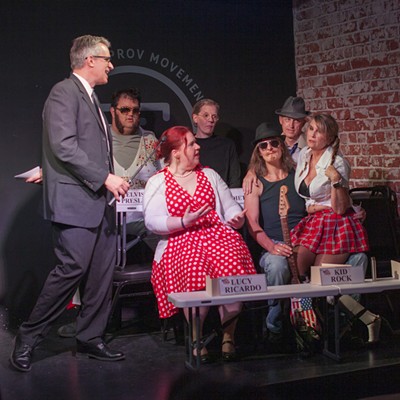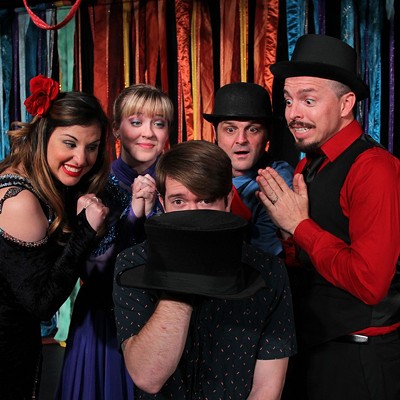Within the first few minutes, you begin to feel ill at ease. As the story progresses, you feel uncomfortable, but invested. By the end, you feel profoundly unsettled.
This is the effect How I Learned to Drive, currently onstage at Live Theatre Workshop, can have. It's a difficult piece, provocative and disturbing, and director Sabian Trout and her cast capture its harsh truths effectively.
Paula Vogel's play, which won the Pulitzer Prize for Drama in 1998, tackles head-on a subject rarely given life onstage: It's a story of incest and familial sexual abuse between uncle and niece. Although the play is hard to witness, thanks to the skill and humor with which Vogel constructs her play—and the unflinching way in which LTW's cast delivers its innocence, its pain and its wrenching honesty—you can't help but respect its heart and its fearlessness. If you don't mind being challenged, you will appreciate this production.
Vogel has chosen a presentational style to trace the youth of "Li'l Bit" (Holli Thenhaus) as it intersects with her Uncle Peck (Keith Wick). A grown-up Li'l Bit addresses us directly, candidly introducing the characters and setting up the story. The stage is bare except for a few chairs and a handful of actors. Uncle Peck is identified, and the three other actors we see (Amanda Gremel, Rhonda Hallquist and David Alexander Johnston) constitute a Greek Chorus, as Vogel calls them; they will become various characters—family members, high school friends—as well as narrators and guides who will also often address us directly.
Li'l Bit takes us back to 1969 in rural Maryland, the year she is 17, graduating from high school and preparing to go to college. The actors move two of the onstage chairs together to create the front seat of a car, with Uncle Peck in the driver's seat, and Li'l Bit his passenger. The two talk amicably—a spin around town like this is obviously a common event for these two. But what is not common to us is Peck nonchalantly asking Li'l Bit if he can undo her bra. She says he can—but that's as far as it will go today, she says, all the while talking about college plans and other rather mundane things. No, no, we think; this is all wrong. The unease begins to take hold, and within seconds, we realize we have stumbled into something awkward and intimate, a story which will not let us go until it all plays out.
Vogel uses learning to drive as both device and metaphor. One member of the Greek Chorus will announce or define a term like "defensive driving," setting up the ensuing scene. "Using the reverse gear" allows the action to back up in time so we can see how the pattern of abuse developed. Vogel uses short scenes to fill in the story, showing family dinners, a high school dance, three generations of the family's women talking about men and marriage and sex. (Li'l Bit wonders: Why does everything have to hurt for girls? And why is there always blood?)
Then we have the scenes between Uncle Peck and Li'l Bit, which also skip around in time, and during which we are privy to moments of confusion, of anger, of tenderness and of breath-stealing pain.
Much of the effectiveness of this production blooms from the courageous vulnerability Thenhaus reveals in her characterization of L'il Bit. A smart young girl who develops early, her Li'l Bit struggles to be more than a body with breasts in a world in which the assumption is that the measure of a woman lies in her physical attributes and a willingness to accommodate. Thenhaus soars in this role.
Wick also does a highly skillful job with his characterization of Uncle Peck. To his great credit, he gives us a Peck who is, in many ways, a good man—caring, tender, never an ogre enough to make us hate him. He has been victimized, too. Wick makes a dangerous and morally bankrupt character a sympathetic one, and that is no small accomplishment.
The episodic nature of Vogel's piece—short scenes, jumping around in time, a moment of exposition here, an intense focus there—requires all of the players to be attuned and precise in order to create intelligible storytelling and effective dramatic movement. Gremel, Hallquist and Johnston all contribute artfully, fully invested when they need to be, and offering unobtrusive support when required. Trout has orchestrated the group well, helping them find the heart of the story and trusting them to deliver it to us with great sensitivity.
Although we see how Li'l Bit is damaged, we don't see the protracted recovery that would be needed for her to become the well-adjusted woman she seems to be. This is obviously beyond the scope of Vogel's piece, and we can accept that Li'l Bit is a survivor. Still, Vogel leaves us with what feels like an overly happy ending.
So why would you want to see a play that deals with such a difficult subject? Because it's important that we confront the unhappy reality that this kind of thing happens in our own families—far more frequently than we know or want to admit. It's ugly, and we want to avert our eyes, make excuses, change the subject. But due to our unwillingness to deal with such things, we tacitly engage in a cover-up which perpetuates such horrifying victimization.
You also want to see this play because it's well-done—moving, thoughtful and penetrating. It's a sterling example of how and why theater is such a powerful—and important—part of our culture.










